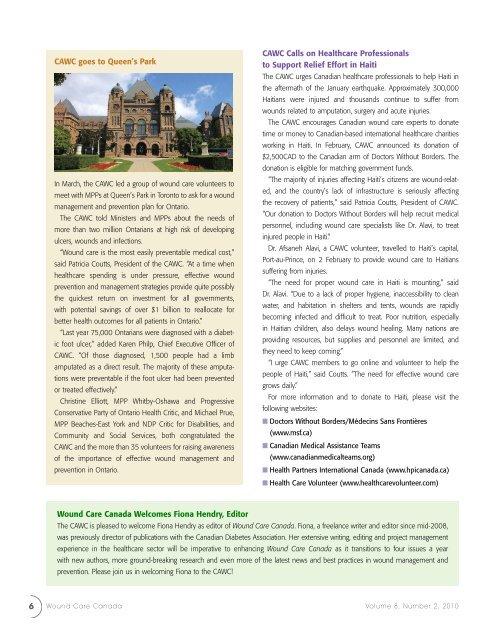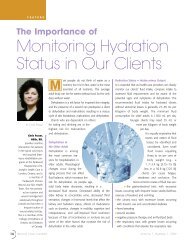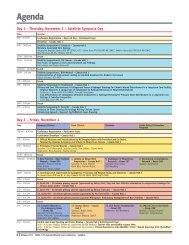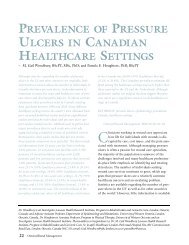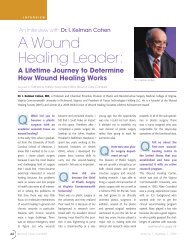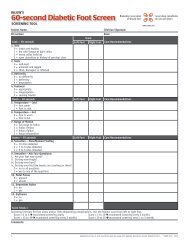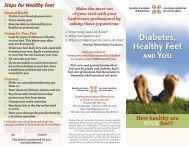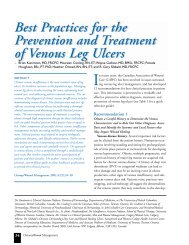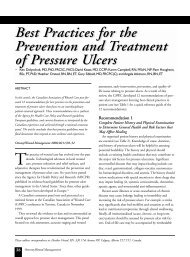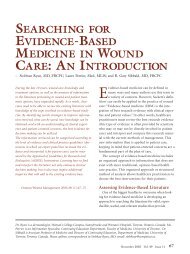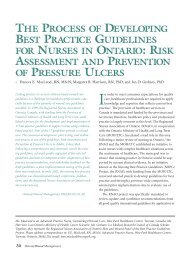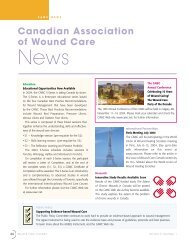Bilateral Lower Limb Lymphedema Secondary to Morbid Obesity
Bilateral Lower Limb Lymphedema Secondary to Morbid Obesity
Bilateral Lower Limb Lymphedema Secondary to Morbid Obesity
Create successful ePaper yourself
Turn your PDF publications into a flip-book with our unique Google optimized e-Paper software.
6<br />
CAWC goes <strong>to</strong> Queen’s Park<br />
In March, the CAWC led a group of wound care volunteers <strong>to</strong><br />
meet with MPPs at Queen’s Park in Toron<strong>to</strong> <strong>to</strong> ask for a wound<br />
management and prevention plan for Ontario.<br />
The CAWC <strong>to</strong>ld Ministers and MPPs about the needs of<br />
more than two million Ontarians at high risk of developing<br />
ulcers, wounds and infections.<br />
“Wound care is the most easily preventable medical cost,”<br />
said Patricia Coutts, President of the CAWC. “At a time when<br />
healthcare spending is under pressure, effective wound<br />
prevention and management strategies provide quite possibly<br />
the quickest return on investment for all governments,<br />
with potential savings of over $1 billion <strong>to</strong> reallocate for<br />
better health outcomes for all patients in Ontario.”<br />
“Last year 75,000 Ontarians were diagnosed with a diabetic<br />
foot ulcer,” added Karen Philp, Chief Executive Officer of<br />
CAWC. “Of those diagnosed, 1,500 people had a limb<br />
amputated as a direct result. The majority of these amputations<br />
were preventable if the foot ulcer had been prevented<br />
or treated effectively.”<br />
Christine Elliott, MPP Whitby-Oshawa and Progressive<br />
Conservative Party of Ontario Health Critic, and Michael Prue,<br />
MPP Beaches-East York and NDP Critic for Disabilities, and<br />
Community and Social Services, both congratulated the<br />
CAWC and the more than 35 volunteers for raising awareness<br />
of the importance of effective wound management and<br />
prevention in Ontario.<br />
Wound Care Canada Welcomes Fiona Hendry, Edi<strong>to</strong>r<br />
CAWC Calls on Healthcare Professionals<br />
<strong>to</strong> Support Relief Effort in Haiti<br />
The CAWC urges Canadian healthcare professionals <strong>to</strong> help Haiti in<br />
the aftermath of the January earthquake. Approximately 300,000<br />
Haitians were injured and thousands continue <strong>to</strong> suffer from<br />
wounds related <strong>to</strong> amputation, surgery and acute injuries.<br />
The CAWC encourages Canadian wound care experts <strong>to</strong> donate<br />
time or money <strong>to</strong> Canadian-based international healthcare charities<br />
working in Haiti. In February, CAWC announced its donation of<br />
$2,500CAD <strong>to</strong> the Canadian arm of Doc<strong>to</strong>rs Without Borders. The<br />
donation is eligible for matching government funds.<br />
“The majority of injuries affecting Haiti’s citizens are wound-related,<br />
and the country’s lack of infrastructure is seriously affecting<br />
the recovery of patients,” said Patricia Coutts, President of CAWC.<br />
“Our donation <strong>to</strong> Doc<strong>to</strong>rs Without Borders will help recruit medical<br />
personnel, including wound care specialists like Dr. Alavi, <strong>to</strong> treat<br />
injured people in Haiti.”<br />
Dr. Afsaneh Alavi, a CAWC volunteer, travelled <strong>to</strong> Haiti’s capital,<br />
Port-au-Prince, on 2 February <strong>to</strong> provide wound care <strong>to</strong> Haitians<br />
suffering from injuries.<br />
“The need for proper wound care in Haiti is mounting,” said<br />
Dr. Alavi. “Due <strong>to</strong> a lack of proper hygiene, inaccessibility <strong>to</strong> clean<br />
water, and habitation in shelters and tents, wounds are rapidly<br />
becoming infected and difficult <strong>to</strong> treat. Poor nutrition, especially<br />
in Haitian children, also delays wound healing. Many nations are<br />
providing resources, but supplies and personnel are limited, and<br />
they need <strong>to</strong> keep coming.”<br />
“I urge CAWC members <strong>to</strong> go online and volunteer <strong>to</strong> help the<br />
people of Haiti,” said Coutts. ”The need for effective wound care<br />
grows daily.”<br />
For more information and <strong>to</strong> donate <strong>to</strong> Haiti, please visit the<br />
following websites:<br />
■ Doc<strong>to</strong>rs Without Borders/Médecins Sans Frontières<br />
(www.msf.ca)<br />
■ Canadian Medical Assistance Teams<br />
(www.canadianmedicalteams.org)<br />
■ Health Partners International Canada (www.hpicanada.ca)<br />
■ Health Care Volunteer (www.healthcarevolunteer.com)<br />
The CAWC is pleased <strong>to</strong> welcome Fiona Hendry as edi<strong>to</strong>r of Wound Care Canada. Fiona, a freelance writer and edi<strong>to</strong>r since mid-2008,<br />
was previously direc<strong>to</strong>r of publications with the Canadian Diabetes Association. Her extensive writing, editing and project management<br />
experience in the healthcare sec<strong>to</strong>r will be imperative <strong>to</strong> enhancing Wound Care Canada as it transitions <strong>to</strong> four issues a year<br />
with new authors, more ground-breaking research and even more of the latest news and best practices in wound management and<br />
prevention. Please join us in welcoming Fiona <strong>to</strong> the CAWC!<br />
Wound Care Canada Volume 8, Number 2, 2010


